Note: If an image ever fails to appear - refresh your page, it really is there
Flags of the United States of America
Military and Naval Flags of the United States of America
Historically, the armed forces of the United States were defined in terms of the land and naval forces of the United States, as described in the Constitution. The land force is the United States Army and its components. The US Air Force is derived from the US Army Air Corps. The Army has reconstituted the former Air Corps as a branch within the Army. (Interestingly enough, some think that the Air Force is currently qualifying more drone "pilots" than it is aircraft pilots.) The naval forces of the United States are the U.S. Navy, and its reserve components. There are two additional uniformed services, the Marines, and the U.S. Coast Guard, who both operate as a part of the naval forces during wartime.
Flags of the United States Air Force
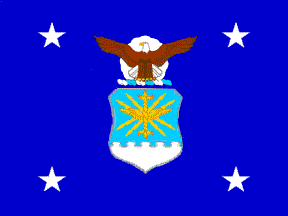
Secretary of Air Force Flag
|
Flag of the Secretary of Air Force
The Secretary of the Air Force is the civilian head of the Department of the Air Force and reports to the Secretary of Defense.
|

US Air Force Flag
|
Flag of the United States Air Force
The United States Air Force is a branch of the U.S. armed forces responsible for aerial warfare, space warfare, and cyber warfare. It was initially part of the U.S. Army and was formed as a separate branch in 1947.
|
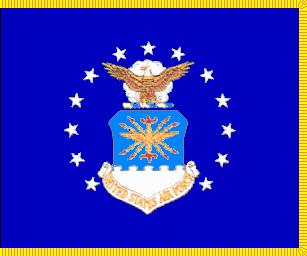
US Air Force Flag
(Ceremonial)
|
Flag of the United States Air Force (Ceremonial)
The United States Air Force, like the US Coast Guard, has two distinctive flags. One is a flag use at all air bases and establishments; the other is a military standard for use on ceremonial occasions.
|
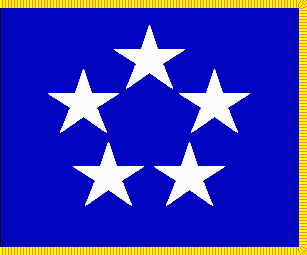
GenAF Flag
|
General of the Air Force
Thus far there has only been one five-star General of the Air Force. During World War II the rank was held by General Hap Arnold.
|

4-Star General Rank Flagg
|
Air Force General
|
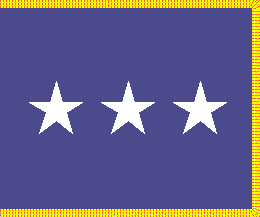
3-Star General Rank Flag
|
Air Force Lieutenant General
|

2-Star General Rank Flag
|
Air Force Major General
|
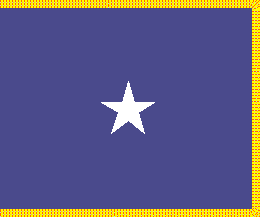
1-Star General Rank Flag
|
Air Force Brigadier General
|

SAC Flag
|
Strategic Air Command 1946-1992
Known as the Strategic Air Command (SAC) and the North American Aerospace Defense Command (NORAD)
|

USFK Flag
|
United States Forces Korea?
|

USFJ/JSDF Flag
|
United States Forces Japan
|

Air Defense Command Flag
|
Air Defense Command Flag
????
|
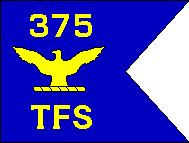
Flag
|
375th Tactical Fighter Squadron Guidon
|

Flag
|
First Fighter Wing
The 1st FW descends from the 1st Pursuit Group of the US Army Air Corps, and its emblem is an adaptation of the previous Army-style coat of arms. The 1st FW is part of the active Air Force, flying F-15C fighters. Its assigned squadrons include the famous 94th--the "Hat in the Ring" squadron of WW I fame.
|

Flag
|
129th Rescue Wing
Organizational Flag, 129th Rescue Wing. The 129th RW is a unit of the California Air National Guard. It has two flying squadrons, one with C-130 tanker aircraft and one with HH-60 rescue helicopters. It began life as a transport unit, later converting to the combat rescue role. The 129th regularly flies rescue missions in the US and overseas, and it is credited with saving nearly 300 lives.
|
Flags of the United States Army Air Corps
Prior to 19?? the Air Force was part of the United States Army, not a separate military branch as it is today. Known then as the Army Air Corps it was formed in 19 and existed until 19 The Army Air Corps was the U.S. Army's aviation branch, to which belonged all flying units and all support units, such as aviation maintenance squadrons, which were aviation-oriented. Its branch badge was the winged propeller. The Army Air Forces consisted of the Army Air Corps plus units from other branches, e.g. Military Police, Coast Artillery (antiaircraft units), Transportation, Quartermaster, etc., that were necessary to support the tactical employment of air units. Thus, for example, the Eighth Air Force included a variety of non-Army Air Corps units. The Army Air Corps was a branch of service; the Army Air Forces was the combat organization.
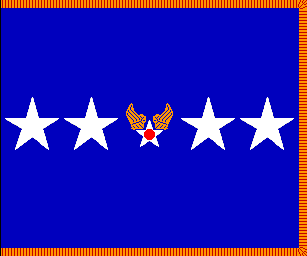
Flag
|
Commanding General Army Air Forces
Color, Commanding General, U.S. Army Air Forces: Five general officers of the Army were authorized silk colors--the General of the Armies (Pershing), the Chief of Staff, the CG Army Ground Forces, the CG Army Service Forces and the CG Army Air Forces. For the latter, the field of the color was ultramarine blue. The shoulder sleeve insignia (SSI) for Army Air Forces was centered on the color, but with its ultramarine blue disk invisible against the field of the flag. On either side of the insignia were two white stars to denote the CG's four-star rank. The CG, USAAAF was General H.H. "Hap" Arnold. Dimensions for this flag were 4 feet 4 inches at the hoist by 5 feet 6 inches on the fly.
|
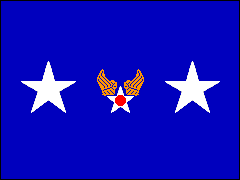
Flag
|
General Officer HQ USAAF Staff
Field and Boat Flag, General Officer HQ USAAF Staff: Generals on the staff of HQ USAAF were authorized a field and boat flag of wool bunting with the SSI for Army Air Forces centered and white stars according to rank. Like the color of the CG, USAAF, this flag's field was ultramarine blue with the USAAF SSI centered, its blue disk invisible against the field of the flag. One star was placed on either side of the SSI for a major general and one above the insignia for a brigadier general.
|
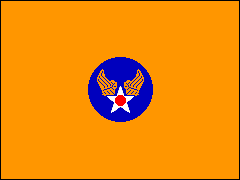
AAC/AAF HQ Flag
|
Headquarters Army Air Corps/Army Air Force (WWII)
|
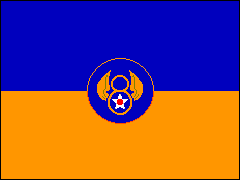
8th AAC Flag
|
Eighth Army Air Corps (WWII)
The Eighth Air Force, based in the UK, carried the main burden of the U.S. strategic air offensive against Germany. Its flag consisted of horizontal stripes of ultramarine blue and golden orange, with the Eighth AF shoulder sleeve insignia centered. The flags were made of wool bunting with dimensions of 3 feet at the hoist by 4 feet on the fly.
|

67th Fighter Wing Flag
|
67th Fighter Wing (WWII)
Distinguishing Flag, 67th Fighter Wing: On a field of golden orange, the unit name and number were applied in ultramarine blue. The flags were made of wool bunting with dimensions of 3 feet at the hoist by 4 feet on the fly.
|
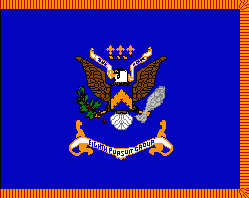
Flag
|
8th Pursuit Group
Organizational Standard, 8th Pursuit Group: The Group was the color-bearing unit of the Army Air Corps. AAC Groups were classed as mounted/mechanized units and so they had a silk standard with dimensions of 3 feet at the hoist by 4 feet on the fly with 2 1/2-inch fringe. The field was ultramarine blue; fringe and piping were golden orange. Pursuit groups were retitled "fighter groups" later in the war, but existing standards were not replaced until they wore out. In most respects these standards were identical to contemporary U.S. Army organizational colors.
|
Other Flags of the United States Air Force
The flags in this section are all related to the United States Air Force in some way, but not necessary official. They incude organizational flags, such those for United States Air Force Academy, and related organizational flags such as the Civil Air Patrol flag, but also civilian non-regulation commerical flags as well.
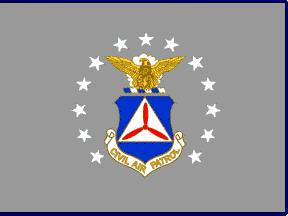
Flag
|
Civil Air Patrol
The Civil Air Patrol (CAP) is a federally supported non-profit corporation that serves as the official civilian auxiliary of the United States Air Force. It is a volunteer organization that includes people from all backgrounds, lifestyles, and occupations. It has three missions: 1. emergency services, which includes search and rescue and disaster relief operations, 2. Public education about air and space programs, and 3. a cadet programs for teenage youth.
|

Flag
|
United States Air Force Academy
The United States Air Force Academy is a military academy for officer candidates of the United States Air Force. Its campus is located just north of Colorado Springs, Colorado. It's first class graduated in 1959, making it the newest official military academy for the military branches. The Academy´s stated mission is "to educate, train, and inspire men and women to become officers of character, motivated to lead the United States Air Force in service to our nation."
|
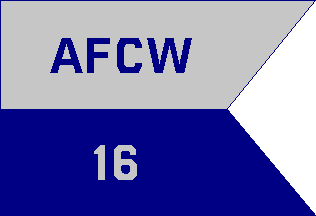
Flag
|
Air Force Academy Guidon
These guidons are used by the cadet squadrons of the U.S. Air Force Academy. They are divided horizontally, silver-gray over blue, with the initials "AFCW" for Air Force Cadet Wing in blue letters on the upper portion and the squadron number (1 through 40) in silver-gray letters on the lower portion.
They have been in use since the late 1950s, but only officially authorized only after 1973. |

Air Force Wings Flag

Air Force Wings Flag
|
United States Air Force Wing Flags (unofficial)
These new style flags are not official, but they are widely used by both civilian and military personal, including on Air Force recruitment materials. The logo seems to have become the un-official logo of the Air Force replacing the old Hap Arnold wings traditional to the Air Force.
There are a number of these flags for sale from various outlets, some with the same
design with colors reversed (as shown here), some with the logo fimbriated on contrasting colors. Some have the full
"U.S. Air Force" inscribed below the logo; others just have "Air Force."
Some forgo the inscription in favor of a ring of 13 stars encircling the logo (some have white stars, others have dark blue stars fimbriated white). The shade of blue also tends to fluctuate with the manufacturer.
They also come in a variety of sizes and ratios. There are garden flags, vertical flags, 2x3 and 3x5 sizes, made in a variety of materials.
The advantage of these unofficial logo flags is people wanting to support their servicemen without having to buy the more expensive official versions of the Air Force flags can do so, and display their patriotism in an economical manner.
|

USAF 60th Anniversary Flag
|
60th Anniversary of the United States Air Force 1947-2007
The Air Force 60th Anniversary flag was raised for the first time March 1, 2007, at the Air Force Memorial in Arlington, Virgina. The ceremony was attended by the Chief of Staff of the Air Force and Secretary of the Air.
The Hap Arnold wings on the logo where meant to signify the Air Force's heritage of ingenuity, courage and resolve. The three spires represent the Air Force Memorial and the Air Force's core values: "integrity first, service before self and excellence in all we do. The logo´s dual shades represent air and space, where the Air Force flies and fights to protect America's freedom."
|

Air Force Defender Flag
|
Air Force Defender
|
|